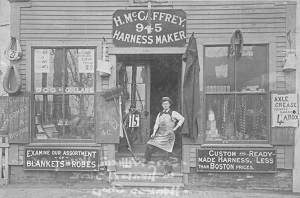For more than a century, beginning in the 1820s, immigrants from England, Scotland, Germany, Ireland, Canada, Italy, Portugal, Poland, Czarist Russia, Barbados, and Haiti flocked to Cambridge, as did thousands of Americans from rural New England and the southern states. Today more than sixty languages are represented among students at the city's high school.

McCaffrey's Harness shop, 945 Cambridge Street, 1891 (Gift of Margaret McCaffrey)